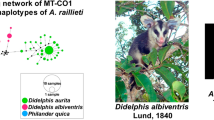Abstract
Given that 14 out of the 25 currently described species of Dermanyssus Dugès, 1834, are morphologically very close to each another, misidentifications may occur and are suspected in at least some records. One of these 14 species is the red fowl mite, D. gallinae (De Geer, 1778), a blood parasite of wild birds, but also a pest in the poultry industry. Using molecular phylogenetic tools we aimed to answer two questions concerning host specificity and synanthropicity: (1) is D. gallinae the only species infesting European layer farms?, and (2) can populations of D. gallinae move from wild to domestic birds and vice versa? Mitochondrial cytochrome oxidase I gene sequences were obtained from 73 Dermanyssus populations collected from nests of wild European birds and from poultry farms and these were analyzed using maximum parsimony and Bayesian inference. Mapping of the observed host range on the obtained topology and correlation with behavioural observations revealed that (1) host range is strongly dependent on some ecological parameters (e.g. nest hygiene, exposure to pesticides and predators), that (2) out of five species under test, synanthropic populations were found only in lineages of D. gallinae, and that (3) at least some haplotypes found in wild birds were very close to those found in association with domestic birds.




Similar content being viewed by others
References
Brännström S, Morrison DA, Mattsson JG, Chirico J (2008) Genetic differences in internal transcribed spacer 1 between Dermanyssus gallinae from wild birds and domestic chickens. Med Vet Entomol 22(2):152–155. doi:10.1111/j.1365-2915.2008.00722.x
Carroll H, Beckstead W, OConnor T, Ebbert M, Clement M, Snell Q, McClellan D (2007) DNA reference alignment benchmarks based on tertiary structure of encoded proteins. Bioinformatics 23(19):2648–2649. doi:10.1093/bioinformatics/btm389
De Lillo E (2001) A modified method for Eriophyoid mite extraction (Acari: Eriophyoidea). Int J Acarol 27(1):67–70
De Souza Amorim D (1982) Classificaçao por sequenciaçao: uma proposa para a denominaçao dos ramos retardados. Rev Bras Zool 11:1–9
Flechtmann HW, Baggio D (1993) On Phoresy of hematophagous ectoparasitic acari (Parasitiformes: Ixodidae and Dermanyssidae) on Coleoptera observed in Brazil. Int J Acarol 19(2):195–196
Hoogstraal H, Aeschlimann A (1982) Tick host specificity. Mitteilungen des Schweizerischen entomologischen Gesellschaft 55:5–32
Huelsenbeck JP, Ronquist F (2001) MRBAYES: Bayesian inference of phylogeny. Bioinformatics 17:754–755. doi:10.1093/bioinformatics/17.8.754
Knee W (2008) Five new species of Rhinonyssidae (Mesostigmata) and one new species of Dermanyssus (Mesostigmata: Dermanyssidae) from birds of Alberta and Manitoba, Canada. J Parasitol 94:348–374. doi:10.1645/GE-1358.1
Lesna I, Wolfs P, Faraji F, Roy L, Komdeur J, Maurice W. Sabelis (2009) Candidate predators for biological control of the poultry red mite Dermanyssus gallinae. Exp Appl Acarol. doi:10.1007/s10493-009-9239-1
Livezey BC, Zusi RL (2007) Higher order phylogeny of modern birds (Theropoda, Aves: Neornithes) based on comparative anatomy II. Analysis and discussion. Zool J Linn Soc 149:1–95. doi:10.1111/j.1096-3642.2006.00293.x
Moss WW (1978) The mite genus Dermanyssus: a survey, with description of Dermanyssus trochilinis, n. sp., and a revised key to the species (Acari: Mesostigmata: Dermanyssidae). J Med Ent 14(6):627–640
Nylander JAA (2004) MrModeltest v2. Program distributed by the author. Evolutionary Biology Centre, Uppsala University
Peterson AP (2008) http://www.zoonomen.net/avtax/frame.html, Version 7.07 (2008.07.30)
Ronquist F, Huelsenbeck JP (2003) MRBAYES 3: Bayesian phylogenetic inference under mixed models. Bioinformatics 19:1572–1574. doi:10.1093/bioinformatics/btg180
Roy L, Chauve CM (2007) Historical review of the genus Dermanyssus Dugès, 1834 (Acari: Mesostigmata: Dermanyssidae). Parasite 14(2):87–100
Roy L, Dowling APG, Chauve CM, Buronfosse T (2008) Delimiting species boundaries within Dermanyssus Dugès, 1834 (Acari: Mesostigmata) using a total evidence approach. Mol Phylogenet Evol. doi:10.1016/j.ympev.2008.11.012
Swofford DL (2001) PAUP*–Phylogenetic Analysis Using Parsimony (*and other methods). Version 4.0B 10. [Computer software and manual]. Sinauer Associates, Sunderland, Massachusetts
Valera F, Casas-Crivillé A, Hoi H (2003) Interspecific Parasite exchange in a mixed colony of birds. J Parasitol 89(2):245–250
Valiente Moro C, Chauve C, Zenner L (2005) Vectorial role of some dermanyssoid mites (Acari, Mesostigmata, Dermanyssoidea). Parasite 12(2):99–109
Valiente Moro C, Fravalo P, Amelot M, Chauve C, Zenner L, Salvat G (2007) Colonization and invasion in chicks experimentally infected with Dermanyssus gallinae contaminated by Salmonella enteritidis. Avian Pathol 36(4):307–311. doi:10.1080/03079450701460484
Wilm A, Mainz I, Steger G (2006) An enhanced RNA alignment benchmark for sequence alignment programs. Algorithms Mol Biol 1(19):1–11
Acknowledgments
Authors would like to warmly thank for help, sampling, advices: O. Bain (Muséum National d’Histoire naturelle (MNHN), Paris, France), Y. Beauvallet (Centre de Recherche sur la Biologie et les Populations d’Oiseaux (CRBPO), MNHN, Paris, France), S. Bonnet (LEGTA, Saint-Genis Laval, France), J. C. Bouvier (INRA unite PSH, Avignon, France), L. Brucy (CRBPO, MNHN, Paris, France), O. Caparros (CRBPO, MNHN, Paris, France), L. Carrier (CRBPO, MNHN, Paris, France), F. Humbert (CRBPO, MNHN, Paris, France), T. Cencek, (Państwowy Instytut Weterynaryjny, Puławy, Poland) M. De Rojas (Universidad de Sevilla, Sevilla, Spain), P. Chabrol (veterinary office, Bourg-en-Bresse, France), J. M. Chavatte (MNHN, Paris, France), O. Dehorter (CRBPO, MNHN, Paris, France), J. Delaporte (Bayer Animal HealthCare, Saint-Ave, France), A. G. Gjevre (National Veterinary Institute of Norway, Oslo, Norway), G. Gory (Museum d’Histoire naturelle, Nîmes, France), N. Guichard (LEGTA, Saint-Genis Laval, France), P. A. Heuch (National Veterinary Institute of Norway, Oslo, Norway), G. Inizan (Bayer Animal HealthCare, Saint-Ave, France), O. Kilpinen (Danish Institute of Agricultural Sciences, Lyngby, Denmark), S. Kreiter (Supagro, Montpellier, France), G. Lallemand (Lycée des Mandailles, Châteauneuf de Galaure, France), B. M. OConnor (Museum of Zoology, University of Michigan, Ann Arbor, USA), B. Paoletti (University of Teramo, Teramo, Italy), M. Rigaux (IUT A, Université Lyon1, Villeurbanne, France), P. Tavernier (Centre de Soins aux Oiseaux sauvages du Lyonnais, Francheville, France), F. Veau (CORA Ardèche, France), Vincent-Martin N. (CRBPO, MNHN, Paris, France), J. Witters (Institute for Agricultural and Fisheries Research, Merelbeke, Belgium).
Author information
Authors and Affiliations
Corresponding author
Glossary
- Mono-/polyxeny
-
Condition of host specificity for a parasite species that needs a single host species/several host species for completion of its development.
- Synanthropic
-
Ecologically associated with humans.
Rights and permissions
About this article
Cite this article
Roy, L., Dowling, A.P.G., Chauve, C.M. et al. Molecular phylogenetic assessment of host range in five Dermanyssus species. Exp Appl Acarol 48, 115–142 (2009). https://doi.org/10.1007/s10493-008-9231-1
Received:
Accepted:
Published:
Issue Date:
DOI: https://doi.org/10.1007/s10493-008-9231-1




